In my previous post, I shared why I eliminated the use of floral foam from our studio. Now, I’d like to share how we did it, a bit generally, and I’ll add with future posts with more technical details for each type of design, geared toward florists interested in transitioning away from floral foam. I’ll focus on event design, since we aren’t a retail florist. So how did we move to foam-free floral design?
SLOWLY…
We didn’t do it all at once, but we haven’t used floral foam in five years. We started with the easiest things to design without foam–low centerpieces–and continued from there until we were no longer dependent on floral foam, even with the most challenging designs.
NO-FOAM OPTIONS FOR LOW CENTERPIECES
VASE SELECTION. The easiest way to avoid using floral foam is to select vases that don’t require it. With shallow vessels like compotes, the flower stems tend to slide up the sides or pop out of the vase. Selecting a vase that is as tall as it is wide will help to prevent this from happening. We often use vases that are 5″ wide by 5″ tall or 6″ wide by 6″ tall. If we are designing in a 5″ x 5″ cylinder, we’ll place floral tape in an X over the top of the vase to provide a bit more structure to the arrangement.
CHICKEN WIRE. For our compote arrangements, we place a ball of chicken wire in the vase and place an X of floral tape to keep it in place. We insert the stems through the chicken wire, which provides even more support than tape alone. Update 3/4/2019: I created a video showing in great detail how I prep a vase with chicken wire. View it here.
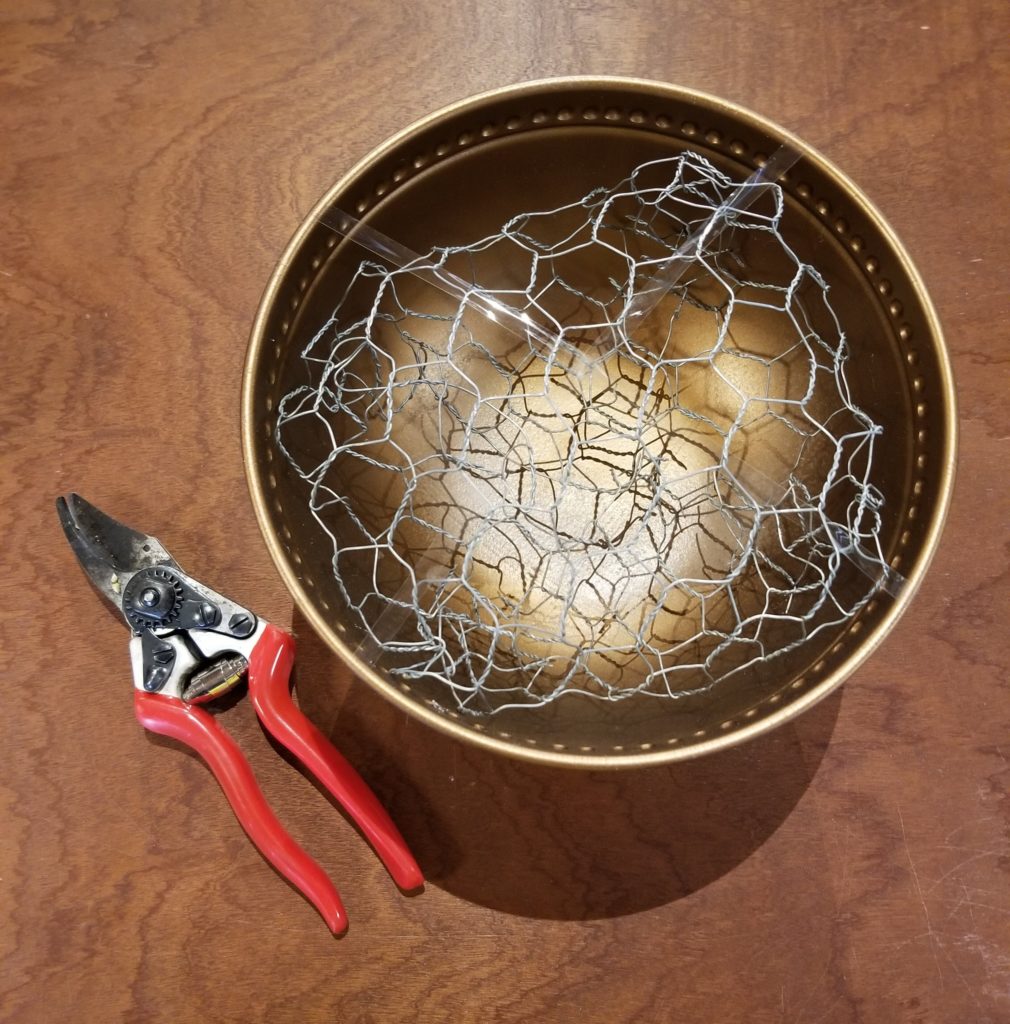
We tried using frogs several years ago for a wedding, but the event ended a bit early and the caterer started clearing the room before we got there. The caterer threw out not only our soy wax votives (which we refill) but also the flower frogs. I’m better at communicating with other vendors now to make sure they know our plans, but after that experience, I decided that chicken wire works just as well, is much more affordable, and is lighter. So now we’e chicken wire loyalists, for the most part.
Syndicate Sales is offering another option, being co-branded with Holly Heider Chapel, which they are calling a “pillow.” It’s similar to the idea behind using chicken wire, but in plastic. They are designed to fit in containers also offered by Syndicate Sales. I bought a few to experiment with, but I’m not a fan of plastic, so I’m sticking with chicken wire.
Whatever foam-free method you use, be prepared for sloshing of water while transporting the arrangements. We fill our vases enough for the stems to be in water, but try not to have more water in them than needed, then top them off with a watering can once on site at the venue. Going back to vase selection, I find that square vases slosh more than cylinder vases. And vases that narrow toward the top slosh less than those that don’t.
THE MORE CHALLENGING NO-FOAM DESIGNS
Some designs are a bit more challenging to design without floral foam. I’d say the most difficult designs are elevated centerpieces (florist jargon for tall centerpieces in a skinny vase), pomanders (which conveniently are going out of style), and flowers attached to structures such as arches and chuppahs.
ELEVATED ARRANGEMENTS. When you see a tall arrangement of flowers in a clear vase, but no stems in the vase, that’s because hidden under the flowers is a block of floral foam, usually taped to a low tray that sits on top of the vase. This method makes it possible to create a perfect ball of flowers by inserting the stems into the block of foam. It also makes it easier to transport the arrangements, because the arrangement in the tray can be transported separately from the tall vase.
Thankfully, the roundy moundy arrangements that have been popular for so many years are making way for a looser, more organic style of design. The looser style lends itself nicely to being designed without floral foam, with the right kind of vase. With a narrow enough vase, we design the arrangement directly in water, usually starting with nearly a bunch of lemon leaf and 7 – 10 stems of hydrangea as the base.
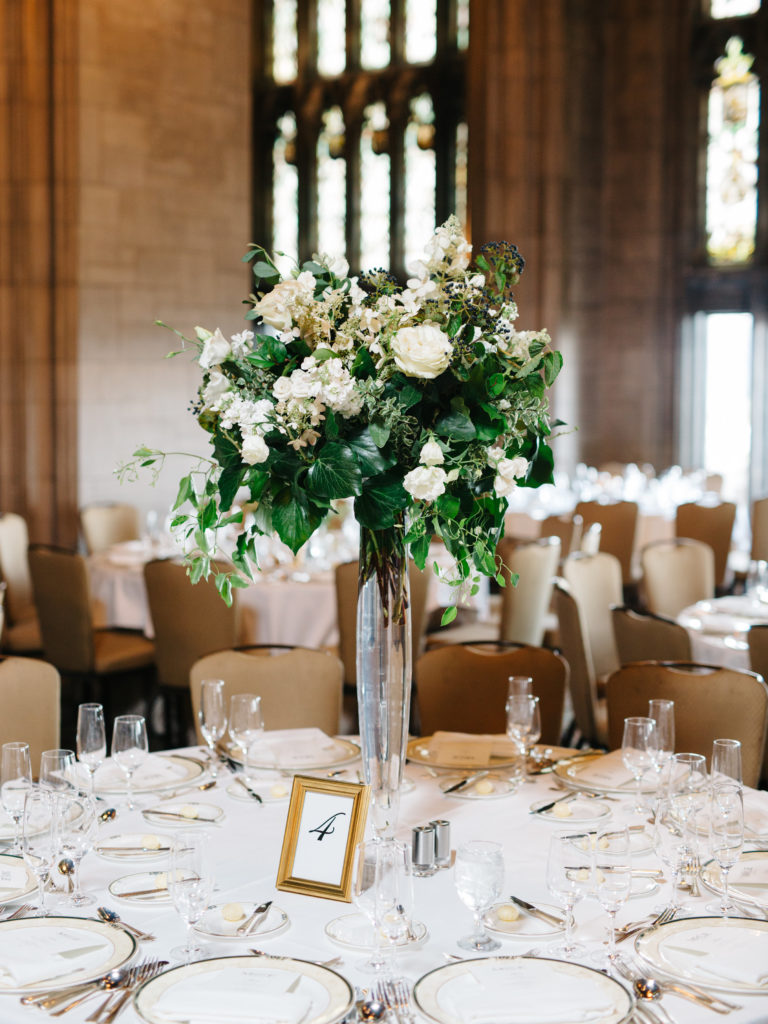
photo by Kyle John Photography. http://www.kylejohnphoto.com/
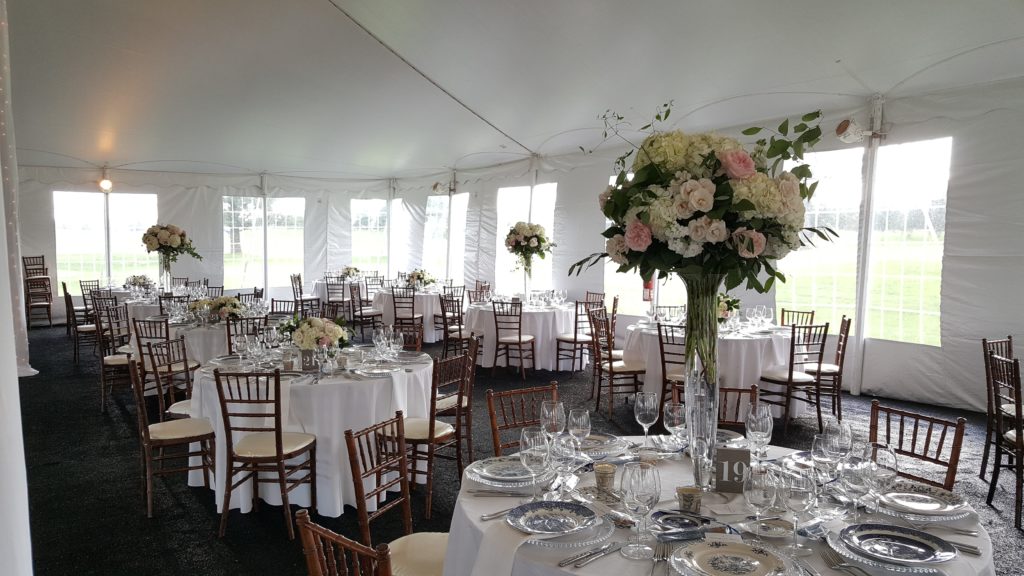
With opaque vases, we sometimes use a ball of chicken wire in the vase, which is what we did in the centerpieces below:
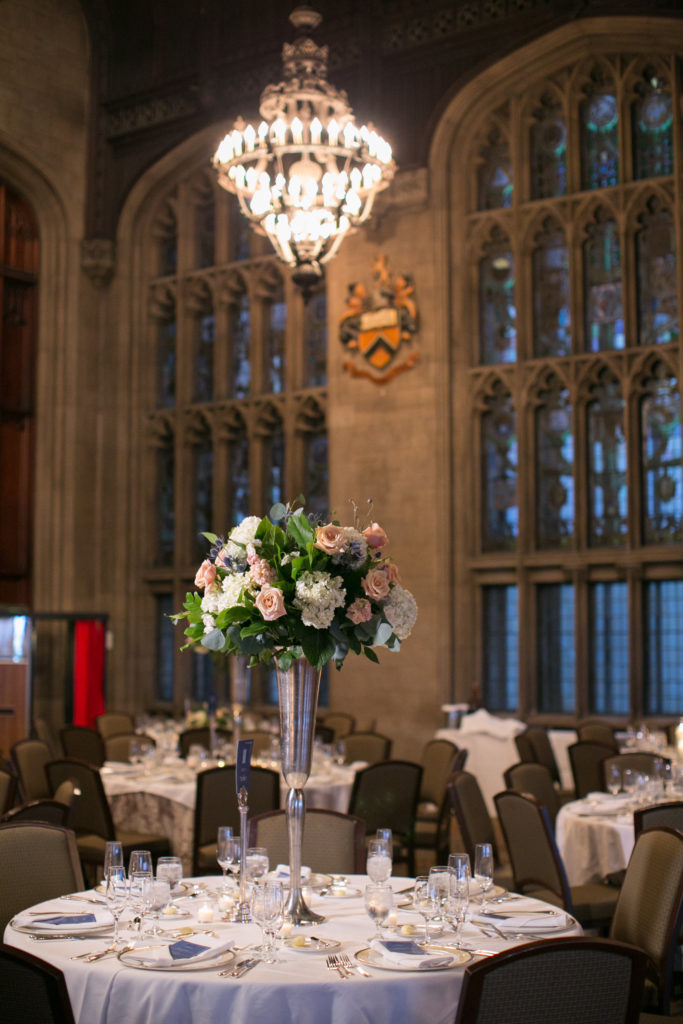
photo by Christy Tyler Photography. http://christytylerphotography.com/
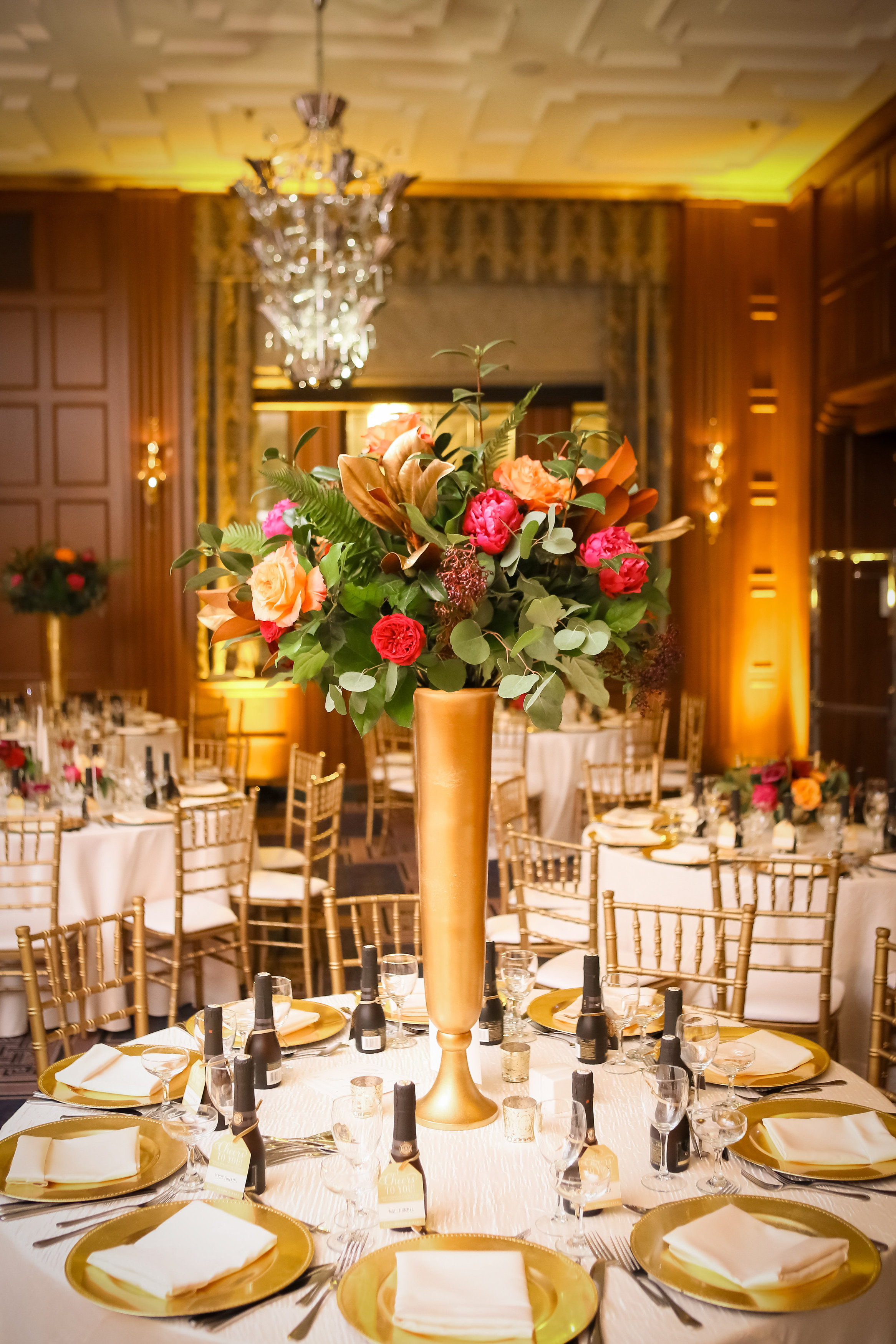
photo by Collin Lyons Photography. http://weddings.colinlyonsphotography.com/dynamic/
If we have an ample budget or a narrow vase, we’ll placed tape over the top of the vase to create a grid to place the stems through. When using a clear vase, we remove the completed arrangement from the vase to change out the water, and during this step we usually remove the tape, since the stems keep each other in place once the vase is full.
POMANDERS. Also known as kissing balls. We haven’t been asked to make these in a while, but they were pretty popular 5 – 10 years back, especially for flower girls to carry. Typically, the base for pomanders is floral foam or styrofoam. Dozens of stems are inserted into a premade sphere of the foam. When asked for pomanders, I simply explained that we don’t use floral foam, and pomanders require the use of foam, so we don’t make them. Instead, I recommended a moss sphere with ribbon and an accent of blooms attached. This was when the rustic look was more popular, so usually people would go for it. If I sensed resistance, I’d recommend switching to a little hand-held bouquet (because flower girls LOVE being just like the big girls!).
ARCHES, CHUPPAHS, AND OTHER STRUCTURES. Most florists also use floral foam to add focal points to structures such as arches and chuppahs. The floral foam provides a water source for the flowers and by using floral foam, the clusters can be designed in the studio ahead of time, brought to the event, and attached to the structure as a finished piece.
If you’re not using floral foam, designing things ahead of time is not really an option. In my experience, the foliage and flowers need to be attached to the structure on site. Instead of floral foam, we use chicken wire to hold flowers in place on our structures. I attach a section of chicken wire with bind wire or zip ties, forming the chicken wire usually into a burrito shape, sometimes around the pole, sometimes in front of the pole, depending on how many flowers we’re adding. Then I insert the stems through the chicken wire, starting with foliage and adding flowers next. Without floral foam there’s no water source, so we place water tubes (which we re-use, of course!) on the more delicate flowers. If the structure will only be up for the ceremony, we use our judgement about which flowers to water tube. The arch and chuppah below were designed with foliage attached piece by piece to the structure, with the focal points having chicken wire as their base.
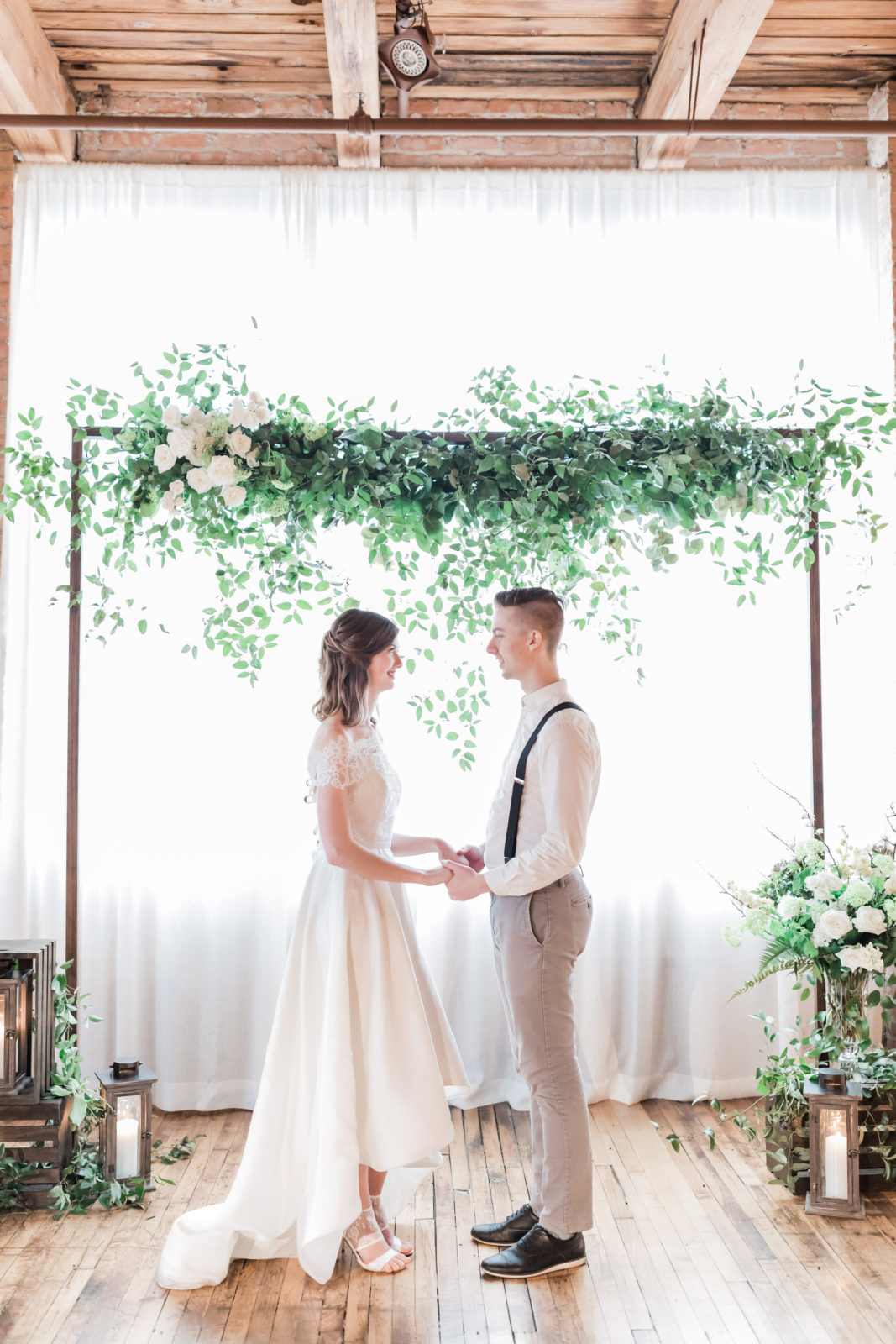
photo by TIffaney Childs Photography. http://tiffaneychilds.com/
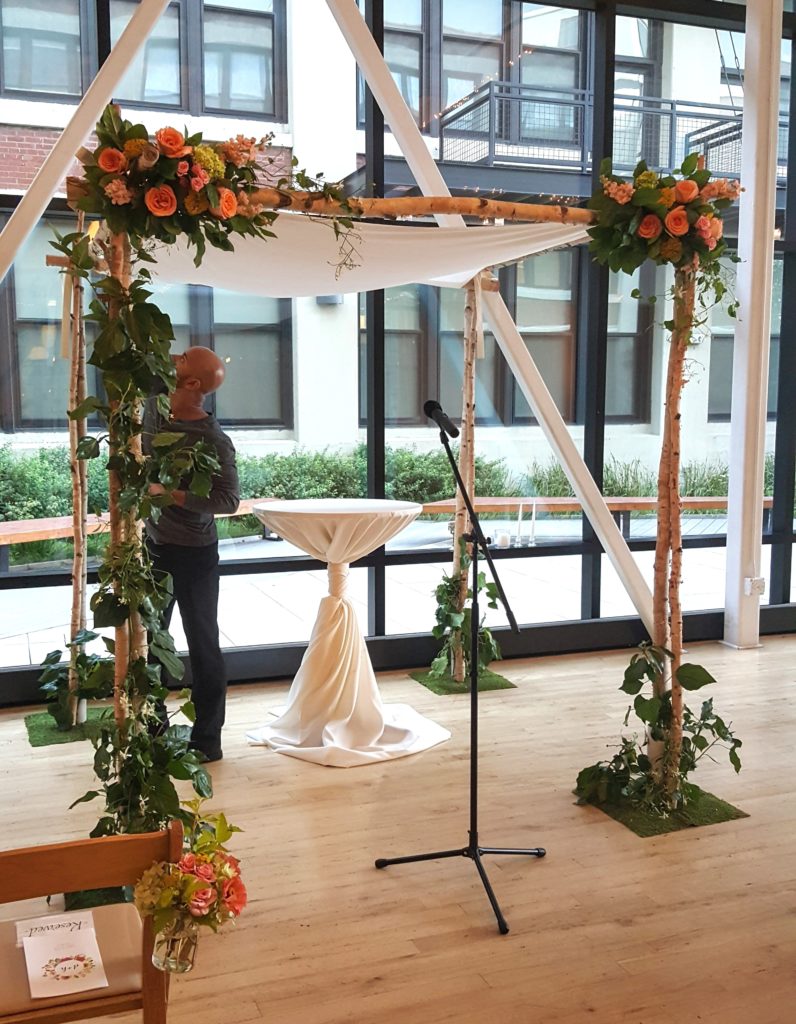
I won’t sugar coat it and say it’s been easy. There have been many times that I’ve been painfully aware of how much easier a particular project would have been if we used foam.
For florists wanting to make the switch away from floral foam, start with the easy stuff. Work into your inventory vase designs that don’t require floral foam. For lower vases, try using a ball of chicken wire instead of foam. Make a part of your client interaction an explanation of why you prefer not to use floral foam, so they’re ready if you have to tell them you don’t create a type of design that is not possible without floral foam.
Like any type of self-improvement (exercise, healthy eating, reading more…I’m still working on all of these!), if you try to make changes to instantly be 100% perfect, you’ll probably end up feeling like you’ve failed. So start slowly, and work to always be moving in the direction of floral foam free floral design. I found my favorite advice in a fortune cookie: “Begin. The rest is easy.”
Thank you Lynn for such a thoughtful and inspiring piece~and your openess regarding your mechanics! It is always easier to continue doing things the way that we always have but, there are consequences to our actions and we must start making changes! Your work is always so lovely and knowing that so much earth friendly conscientiousness goes into your pieces makes them even more beautiful!
Thank you so much, Laura! It’s been so wonderful seeing growing interest in making the floral design industry a more mindful one. I’m happy to be able to play a part in the movement toward running more responsible businesses!
This is beautiful, I have been in the floral industry for 20 years and have been trying to get away from anything contaminating and hurting our Earth, even such as the sprays the Green Glows and the crowning glories, I just don’t believe in them and think they are an extra step that isn’t needed. I’m so excited to have found you through the royal wedding, this is just amazing and I’m looking forward to see techniques and ideas that you use to stay away from the floral foam. Looking forward to your inspirations.
Congratulations on your success and your effort to make the world a better place.
Thanks so much, Rainy! It’s wonderful that so many florists are thinking critically about how we’ve always done things, and what effect our standby tools are having on our health, our staff’s health, and the health of our planet! ~Lynn
Thank you for sharing, very informative and helpful. Inspiring too!
Lynn,
Thank you for this! I’m currently working to be a foam free florist and i was wondering for your tall centerpieces done inside the vase, do you do them all onsite? Or transport them already done?
Thank you!!!
Thank you!
Hi Danielle! We almost always transport them finished. It takes lots of care packaging them up, usually involving nested tall buckets and packing paper. If we’re tight on space, we bind the stems, transfer them to a bucket for transport, then put them back in the vases on site. I can only think of one time we made them on site, because the design was easy enough: all oak branches. I like having as much as possible done before the wedding day! ~Lynn
THANK YOU!! Your tip about the chicken wire “burritos” saved me as I only had about an hour to decorate my first chuppah! I brought greenery garlands and pre-greened clusters and just had to attach with wire to the structure and add some fresh stems. It made the whole thing so much less stressful. Thanks again for sharing your tips about eco floristry. I’ve been shying away from the trickier designs but now I don’t have to.
Hi Teresa, I’m so glad the burrito trick was helpful! Congrats on conquering your first chuppah! The next one will be even easier! ~Lynn
Wonderful blog. Thank you for sharing your experience! You are inspiring.
Aw, thanks so much! I’m glad you’re that you find the blog helpful! ~Lynn